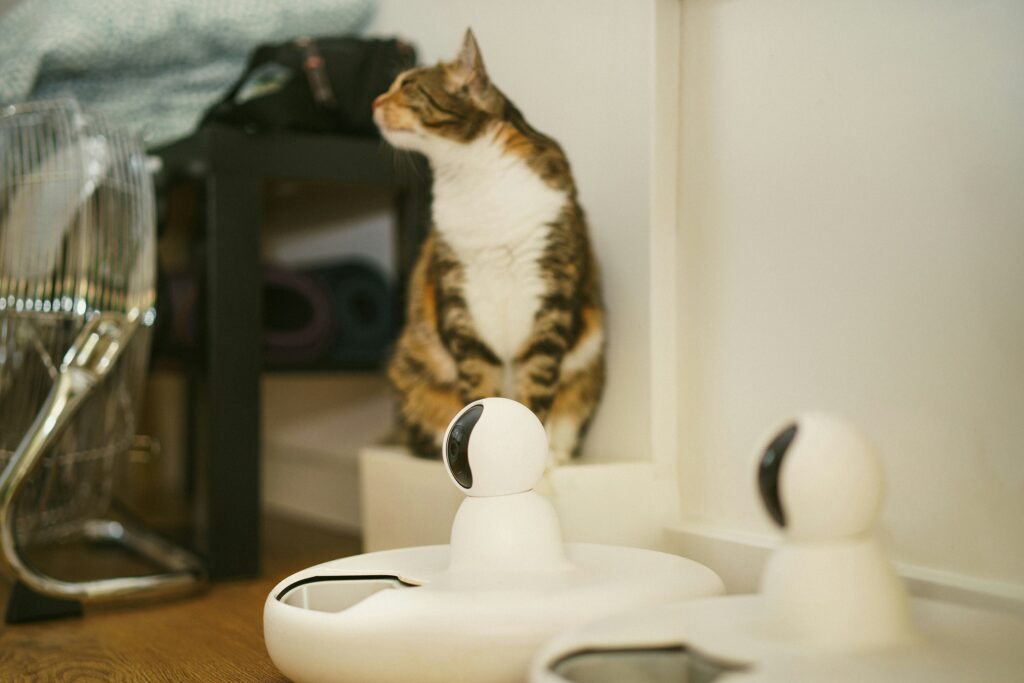Smart pet feeders are everywhere — sleek, clever, and promising to make mealtimes effortless. But with so many new gadgets on the market, it can be tricky to know what’s hype and what’s genuinely helpful.
Whether you’re thinking about a PETKIT, PETLIBRO, or another automatic feeder, this guide separates fact from fiction — and helps you use the tech in a way that keeps your pet healthy, happy, and connected to you.
Let’s clear up the myths…
Myth 1: Smart feeders solve every weight problem

Reality: A feeder helps control portions, but it won’t fix an underlying diet or exercise issue.
If a dog or cat is overweight, portion control is a helpful tool; but effective weight loss requires the right food and more activity. Veterinary guidance and a weight plans are essential. Feeding quantity and quality — plus exercise — are the core pillars of a healthy weight plan. See PDSA’s guidance on feeding and weight management for practical steps.
Myth 2: All smart feeders stop pets fighting over food

Reality: Some do — but only the right device for your household will help.
If you have multiple pets, microchip-activated feeders (e.g., SureFeed-style devices) can keep one greedy pet from stealing another’s meal by only opening for the pet whose chip the feeder recognises. That’s a real game changer for households with different-sized pets or those with resource-guarding behaviours — but it’s not a universal fix. You also need to address behaviour through training and management.
Myth 3: Smart feeders are a veterinary substitute

Reality: Never. They’re a tool, not a medical solution.
Owners sometimes rely on automatic feeders to manage pets with medical needs (diabetes, senior pets on timed medication diets). But automated meal timing doesn’t replace vet care. For pets with specific medical conditions you must consult your vet before changing feeding equipment or schedules.
Similarly, if you have both dogs and cats, it can be tricky to make the right animal gets what. For instance, check out PetMD’s piece on if your dog eats your cat’s food. Situations like these go to show some of the limitations.
Myth 4: Smart feeders can’t be hacked or fail

Reality: These devices are like any other tech products — they can glitch, run out of battery, lose Wi-Fi, or suffer mechanical jams.
Smart feeders bring convenience, but they also introduce tech risks. Choose a model with reliable fail-safes (battery backup, local manual release, robust app alerts). Read independent product reviews (best-buy tests like Which? are helpful) and keep firmware/ apps up to date.
If you use a feeder for a pet that needs guaranteed meals (e.g., medicated or diabetic animals), have a manual plan and check-ins in place.
Myth 5: Any feeder is fine for kittens and puppies

Reality: Size, food format, and behavioural stage matter.
Young animals often need smaller meals more frequently and need supervision when introduced to new devices. Some feeders aren’t suitable for very small kibbles or wet food. Test any feeder with your pup/kitten under supervision and consult breeder or vet recommendations regarding meal frequency.
For instance, the PDSA’s piece on choosing the best feeding method for cats reminds owners to consider life stage and veterinary advice when changing their feeding routines.
How to Make a Smart Feeder Work for Your Pet
1. Define your problem first. Is it portion control? Multi-pet access? Timed meals for shifts? Match the device to the need.
2. Check the basics. Does it have a manual override, battery backup, and easy-to-clean parts? Can it handle the kibble size or wet food you use?
3. Look for behaviour support, not replacement. If you have food-motivated or anxious pets, pair the feeder with training. The Kennel Club, animal behaviourists and veterinary guidance are helpful starting points for managing food-related behaviours.
4. Choose reputable vendors and read independent reviews. Product pages show features; independent testing and veterinary articles can reveal practical pros and cons.
Food For Thought
Smart feeders can genuinely make life easier — for you and your pet. They keep portions steady, reduce stress, and bring structure to busy lives. But like any tool, they work best when used with care, not complacency.
If you’re pairing a smart feeder with another clever home upgrade, check out our latest post on self-cleaning litter boxes — it’s the perfect next read for tech-savvy pet parents.


